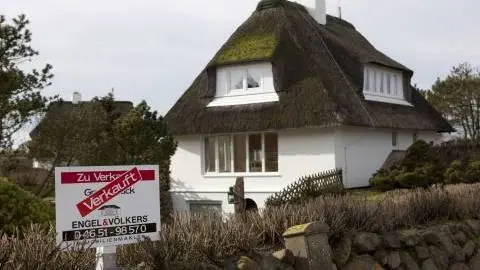Germany: the land of tenants faces scarce supply
Demand for housing in Germany is high and we expect house prices to continue to rise in 2022, albeit at a somewhat slower pace than in previous years. Stagnating supply, high material and construction costs and the fight against climate change will continue to drive up house prices in the coming years, after a 12.2% increase in the fourth quarter of 2021
Lowest home ownership rate in the EU
The home ownership rate in Germany was 50.4% in 2020, marking the lowest ownership rate in the European Union. Of all inhabitants, 56% were living in a flat, while 44% were living in a house. However, strong regional differences exist: in cities, only 24% were living in a house, while in rural areas the share was 63%.
High prices and low interest rates keep demand going
In the fourth quarter of 2021, house prices increased 12.2% year-on-year and between 2015 and 2020 house prices rose by a staggering 39%. As prices and lending for residential real estate are very strong, the Federal Financial Supervisory Authority (BaFin) has announced an increase in capital requirements for lending institutions as of February 2023.
Rents have also risen, but only by some 7% over the past five years, according to the OECD’s Rent Price Index, which explains why the price-to-rent ratio has risen significantly over the same period. Due to the house price increases, owning a property in Germany seems to be less affordable than renting one. Since 2010, the affordability of buying real estate has fallen continuously. Although German households' real gross disposable income per capita rose by roughly 15% over the past five years and interest rates have been at historically low levels, this has not been enough to offset the sharp rise in prices. In addition to regulatory factors and high incidental purchase costs, this might explain why the ownership rate in Germany has hardly increased over the last year and at only around 50%, is the lowest in the European Union.
Overall, the trend is towards demand for more living space per capita and smaller households and this trend is likely to continue over the next five years, according to the German Federal Statistical Office. According to the spring report of the Central Real Estate Committee, new accommodation has been mainly concentrated on small attic apartments. What's more, we expect overall demand for housing to remain high. Building permits have been exceeding completions for years now and the imbalance between supply and demand is currently exacerbated by supply drying up. Between 2016 and 2020 alone, excess demand of some 350,000 apartments has built up. From November 2020 until November 2021, the construction of some 400,000 dwellings was permitted. Due to low construction activity and high building costs in 2021, the number of completions in 2021 might have been lower than in 2020, when some 306,000 dwellings were completed, adding pressure to excess demand. The federal government plans to build 400,000 homes annually, of which 100,000 will be publicly subsidised, though it remains to be seen how successful this plan will be.
Regulation and other trends will influence housing supply and demand
In regions where the market is tight, the German rental market is subject to regulation. The conversion of rental apartments into owner-occupied apartments requires state governmental approval. The “rent brake”, which has been in place since 2015, allows landlords to raise rents by only 10% above the local market level. However, new buildings and extensively renovated apartments are excluded. To prevent speculation with building land, plots of land must in some cases be built on within two to three years and/or held for 10 years.
One trend that will also have an impact on the German real estate market in the future is the green transition. The German government is strongly promoting energy-efficient housing, since some 16% of all greenhouse gas emissions in Germany come from the building sector. Recent plans to become less dependent on Russian oil and gas could accelerate the green transition in housing. The "Immediate Action Program 2022" will provide an additional five billion euros to promote energy-efficient building refurbishment and new buildings, including social housing. However, political support could also become a hurdle. Although housing construction is to be promoted in tight markets and support is also available for increasing efficiency, there is a risk of high bureaucratisation and regulatory hurdles. This could slow down the momentum in residential construction. The German government wants to make approval processes easier, more digital and less bureaucratic, but it remains to be seen whether these plans can be implemented quickly enough.
Outlook: Germany’s residential real estate market is set to continue performing well
Despite heightened uncertainty, Germany’s residential real estate market is set to continue performing well. Demand for housing is high and we expect house prices to continue to rise in 2022, albeit at a somewhat slower pace than in the previous years. Both the mismatch between supply and demand, currently fuelled by stagnating supply, as well as high material and construction costs and the fight against climate change, for which energy-efficient housing plays a major role, will continue to drive house prices up in the coming years.
Download
Download article
31 March 2022
Europe’s housing market looks set to cool This bundle contains {bundle_entries}{/bundle_entries} articlesThis publication has been prepared by ING solely for information purposes irrespective of a particular user's means, financial situation or investment objectives. The information does not constitute investment recommendation, and nor is it investment, legal or tax advice or an offer or solicitation to purchase or sell any financial instrument. Read more

